NVA GUNSHIP TRAP
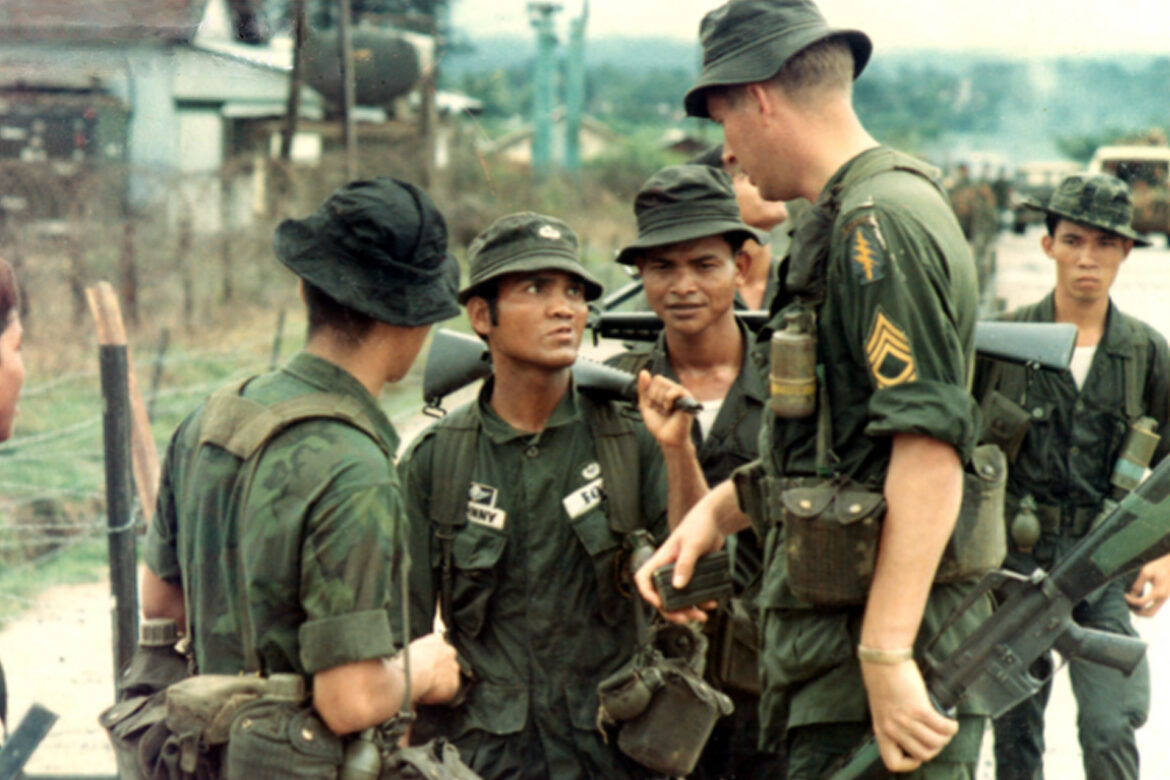
MACV-SOG FOB Team (Photo by Lloyd Adams)
By Randy Bender and Gordon Denniston
MACV-SOG (Military Assistance Command Vietnam – Studies and Observation Group)
The North Vietnamese Army (NVA) was unable to successfully invade across the Demilitarized Zone (DMZ) between North and South Vietnam so they created a supply line through Laos and Cambodia. They violated the treaty they had signed and perpetrated a genocide that continues even today. The communist murdered millions of innocent people in Vietnam, Laos, and Cambodia but the historians and news reporters hide vital facts about that war.
The United States supported the South Vietnamese to repulse that invasion. One important group that was created to attack the North Vietnamese and Chinese was MACV-SOG (Military Assistance Command Vietnam – Studies and Observation Group). This was a secret clandestine group operating behind enemy lines in Laos and Cambodia. These teams were inserted in the middle of concentrations of thousands of NVA soldiers. The NVA soldiers were moving men, weapons, ammunitions, and supplies down the Ho Chi Minh Trail in Laos and later through Cambodia into South Vietnam. These small SOG teams were inserted by helicopter to interdict the communist who were using the Ho Chi Minh Trail. MACV-SOG used all means available to disrupt and kill the communist. The NVA received arms, supplies, and ammunition produced by communist countries around the world. This was the Cold War and Special Forces men were fighting the spread of communism all around the world.
Helicopters were essential to the MACV-SOG mission. Helicopter crews provided transport for teams in and out of enemy territory. Helicopters also provided aerial reconnaissance and gunship support. The U.S.A.F. provided tactical air support and strategic bombing with B-52’s. When a SOG team found themselves surrounded and receiving heavy enemy fire they called for help. They always seemed to get in trouble and the helicopter gunships were usually the first to arrive and provide strafing and rocket fire on the NVA.
MACV-SOG soldiers faced the greatest danger of any group during the Vietnam War while they inflicted massive damage to the North Vietnamese war effort. There were two types of teams: 1. Reconnaissance or 2. Hatchet Force. The majority of men on these teams were native to the Central Highlands of South Vietnam and these men were called Montagnards. The photo in the heading of this page shows a Special Forces sergeant with his Montagnard team members.
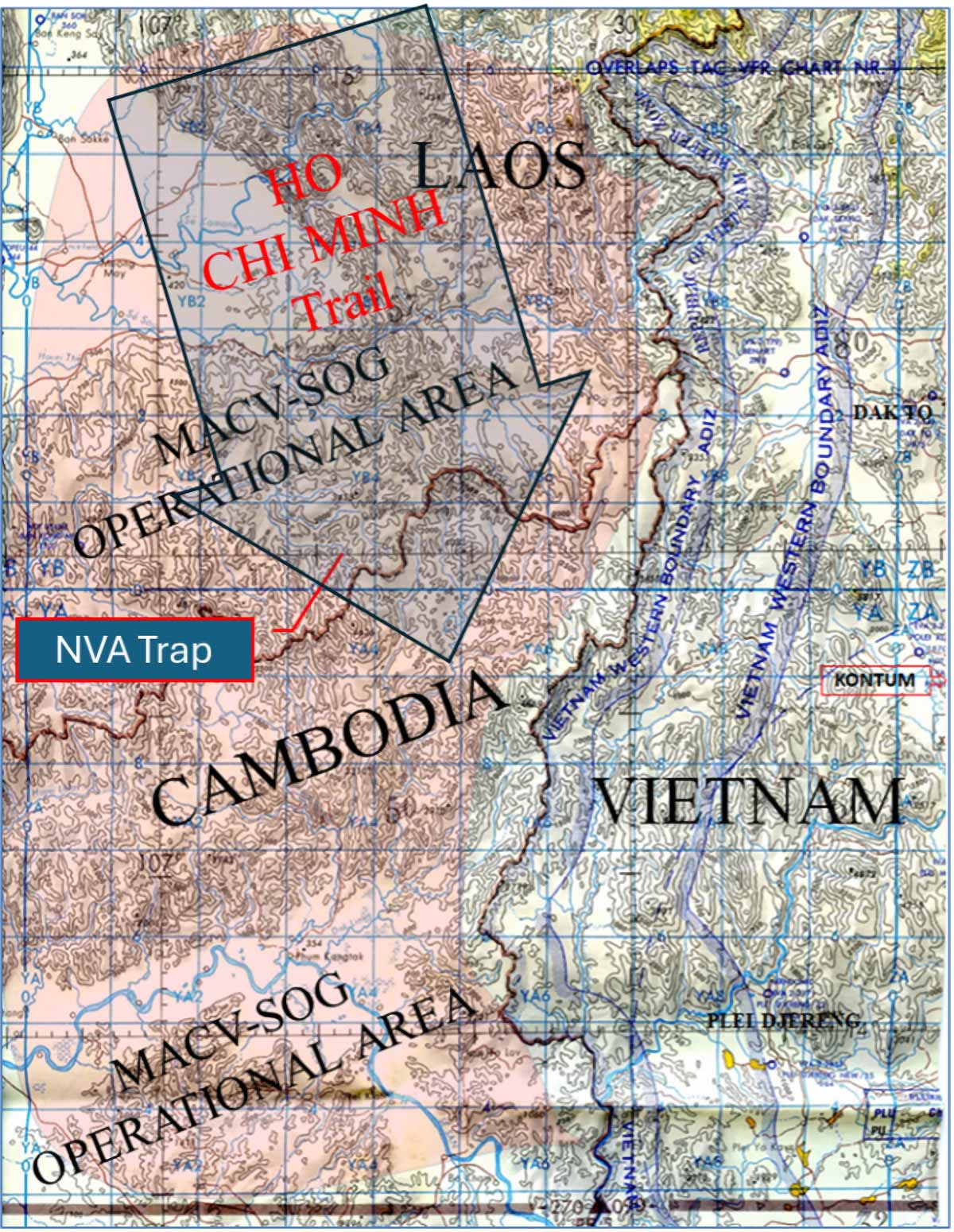
The map above shows the area where this mission took place on 10 April 1967. There were additional areas in Laos and Cambodia not shown on this map where MACV-SOG also operated.
119th AHC in support of SOG Crocodile UH1-C Gunship CROC 3
Click here to watch Gordon Denniston’s video “119th AHC in support of SOG Crocodile UH1-C Gunship CROC 3 (Gordon Denniston)” on YouTube Channel @sfachapter78.
This video covers a period of time in 1967 when the 119th AHC provided support for MACV-SOG at FOB2 in Kontum for top secret operations out of Dak To into Laos. The footage was mostly filmed by Denniston, call sign CROC 3, but also includes shots from crew members Raleigh Hewitt, Don Gaude, Randy Bender, and Pete Markisich.
Click here to read Gordon Denniston’s article about the contributions and organization of the air assets of MACV-SOG from the April 2015 Sentinel.
Most historians, news reporters, college professors, and documentary creators have been promoting communist propaganda and lies about the Vietnam War for over fifty years. They teach the opposite of truth and hide the most vital facts about the Vietnam War. The truth is that the communists in North Vietnam created a Soviet styled dictatorship that operated using murder and terror to invaded Laos and South Vietnam.
Note: Communists consistently use treaties as a tool to advantage their position and then ignore the treaties they signed to force an innocent population to submit to communism. We rarely hear the historians, and others explain that there were substantial treaty violations by the communist that started the Vietnam War: “Indochina – Final Declaration of the Geneva Conference on the Problem of Restoring Peace in Indo-China, July 21, 1954.”
“FINAL DECLARATION, dated the 21st of July 1954, of the Geneva Conference on the problem of restoring peace in Indo-China, in which the representatives of Cambodia, the Democratic Republic of Viet-Nam, France, Laos, the People’s Republic of China, the State of Viet-Nam, the Union of Soviet Socialist Republics, the United Kingdom, and the United States of America took part.”
“The International Agreement on the Neutrality of Laos is an international agreement signed in Geneva on July 23, 1962, between 14 states and Laos. It was a result of the International Conference on the Settlement of the Laotian Question which lasted from May 16, 1961, to July 23, 1962.”
As these treaties were negotiated and signed, the communists were already actively violating every element of these treaties. Communist China, the Soviet Union and North Vietnam were moving massive numbers of men, weapons, ammunition, and supplies from North Vietnam into Laos and then into South Vietnam. MACV-SOG men were collecting evidence of these communist violations and taking actions against that communist invasion.
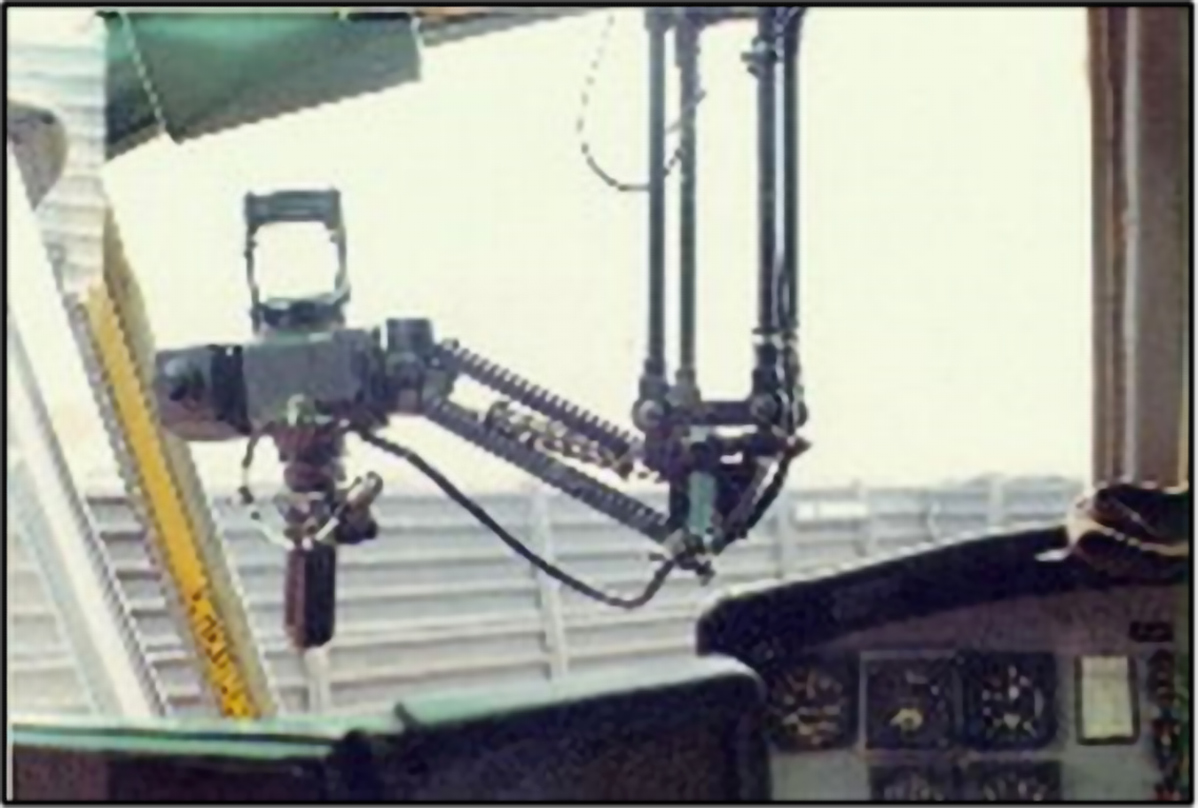
In the photo above, minigun sight that remotely controlled the guns. The lower handle had the trigger on the top and below was a trigger that activated the movement of the gun to point at the target.
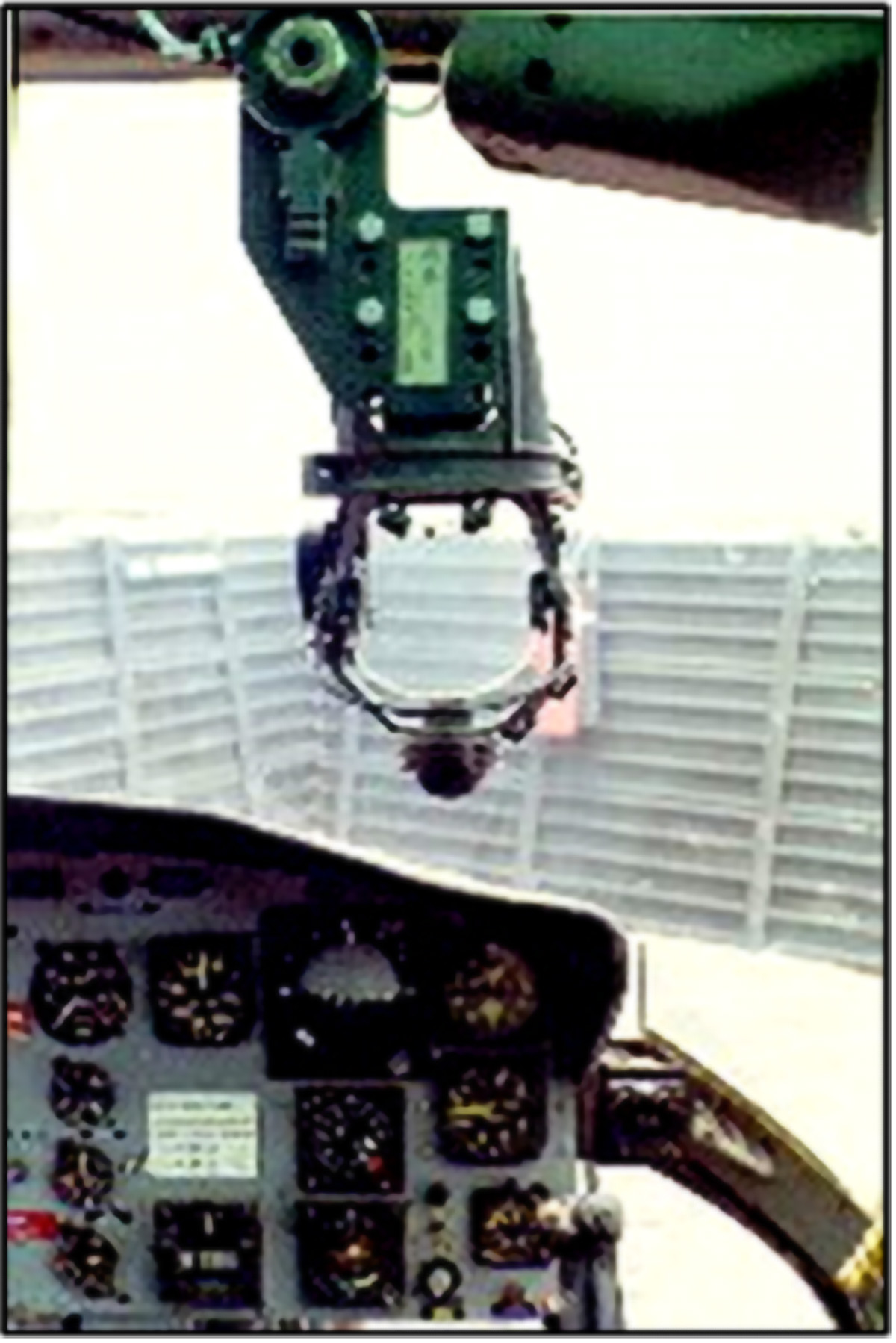
In the photo at left, the rocket sight in the down position.
During the Vietnam War the North Vietnamese Army (NVA) feared the American gunship helicopters that delivered lethal fire power on the NVA enemy troops. One example of this gunship devastation occurred on 10 April 1967, but these gunships found themselves caught in a deadly NVA trap. The only thing that could save the Americans was their tactics, religious providence, and quick responses. The gunships were overloaded and their maximum speed was about 120 knots while flying straight and level. Each gunship had two miniguns. Combined these two miniguns were capable of firing 4,800 rounds per minute. Each aircraft carried fourteen 2.75 inch folding fin rockets with high explosive warheads. The two door gunners each had an M-60 machine gun that could fire 500 rounds per minute. This small package of firepower was vulnerable to enemy ground fire and the larger antiaircraft guns could easily blow these helicopters out of the sky. These helicopters had no armor plates to protect the engine or transmission. Operating these aircraft in the middle of thousands of enemy troops could easily be shot down forty-five miles away from any friendly installations. The aircraft were out in the middle of enemy territory. If these aircraft were shot down the crews would have been brutally tortured and painfully executed on the spot.
These two Army gunships were usually engaged in close air support of MACV-SOG teams fighting in Laos. MACV-SOG were secret teams fighting the NVA by going into Laos and Cambodia. MACV-SOG men had a dangerous mission where they were inserted into the Ho Chi Minh Trail area to interrupt the communist flow of weapons, men, supplies, and ammunition going into South Vietnam. The mission on this day was challenging but provided us with the freedom to independently search and destroy the NVA. Find the enemy and kill them. This was a difficult objective since the communists were operating under a dense canopy jungle and they were skilled in the use of camouflage. Our instruction were to fly into Laos and connect with a Forward Air Controller (FAC) by radio. On this day, the FAC thought he had observed indications that the NVA had established their storage and depot of supplies and weapons in this area. The FAC could not confirm that the enemy was concentrated in his target area so we were requested to go down for closer observations. These areas could be deceiving where it just looks like undisturbed thick jungle. There were few open areas covered with smaller trees and elephant grass.
We used our Minigun Sight to point the guns in the general target area but quickly used the tracers to move the fire toward the intended target.
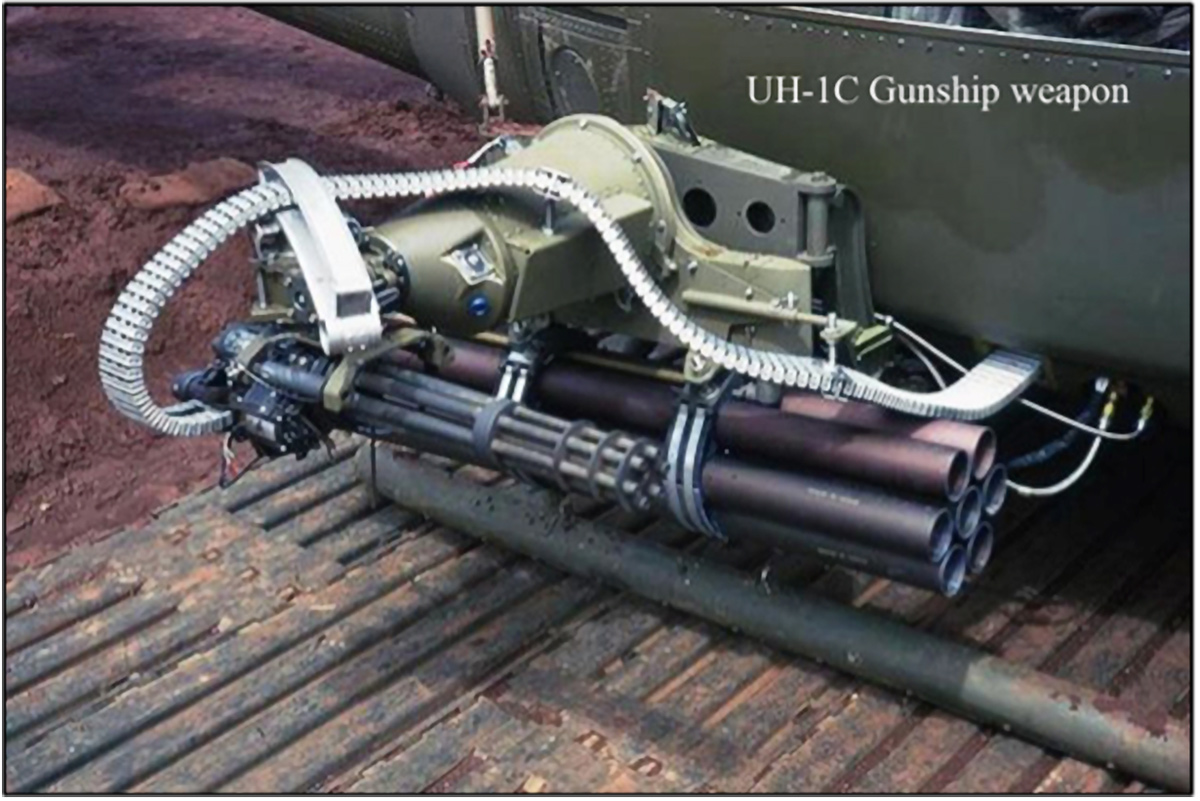
Photo above: the complete weapon delivery system. Shows both 2.75 in. rocket tubes and minigun with feeder chute for 7.62 mm ammunition.
We were constantly reloading since it only took minutes to fire all of our ammunition and rockets. After we had unloaded our ammunition, we must hurry back to reload and refuel.
To get a better view of the area we could have slowed down or climbed up to 200 feet. That temptation would have provided great visibility but that is the best way to get yourself killed.
If you want to live you must get down extremely close to the ground (about 3 or 4 feet above ground) or fly between the trees and keep up maximum speed. These are basic gunship rules of survival.
Photo below is beautiful valley of jungle. Nothing to see here.
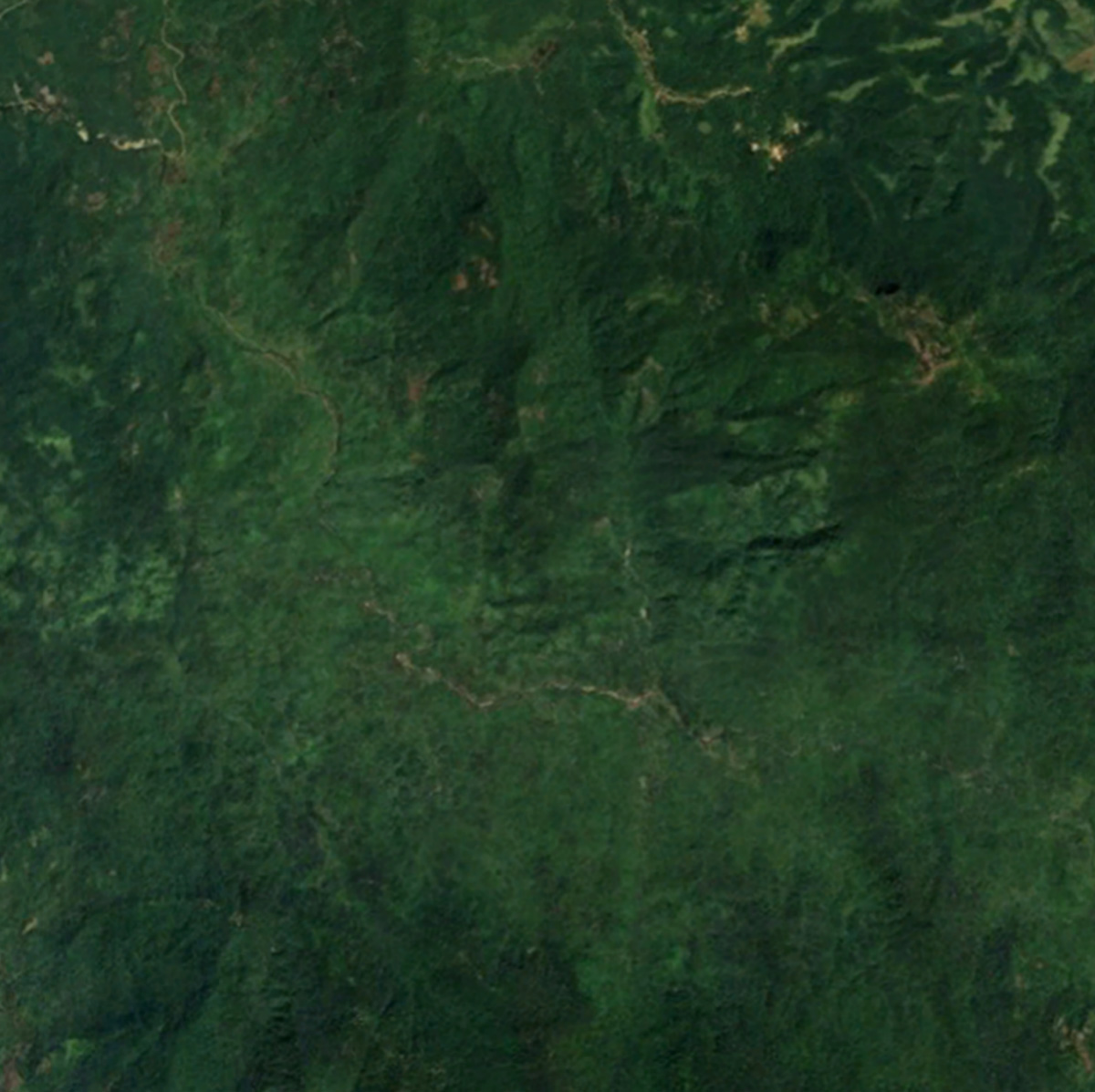
Beautiful green jungle with nobody home. But are they?
We started our high speed dive into the area to look for communists.
Our Forward Air Controller had ask us to go down and look for NVA activity. The ridge line shown in the red dashed lines surrounded the valley of interest.
The dotted yellow line shows our path of flight to searching for any NVA concentration of troops or equipment. We flew around the valley at low level four or five times looking for communist. After three or four circles around the valley, we did not see any indications of enemy presence.
The FAC asked us to take one more look at the area.
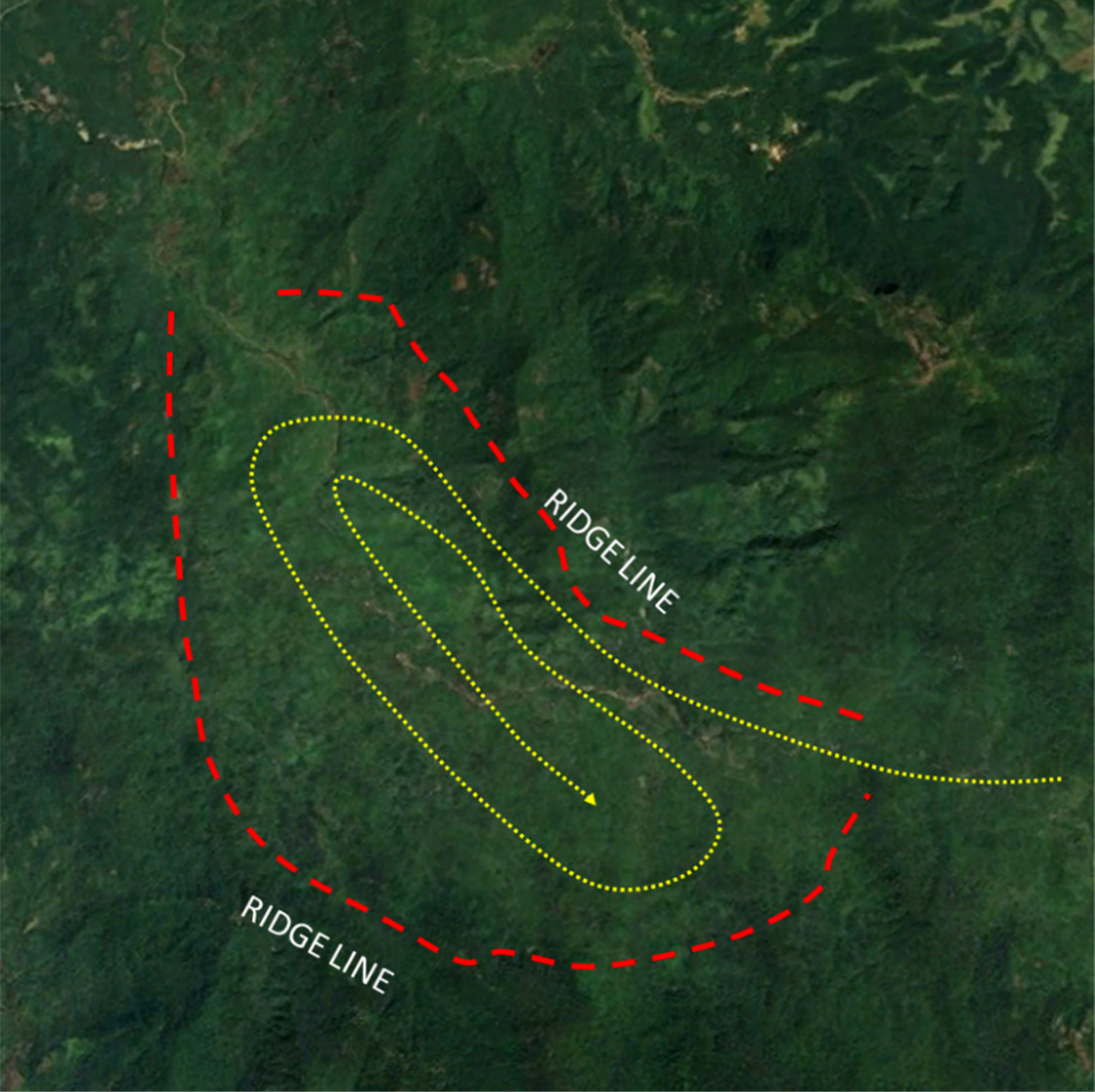
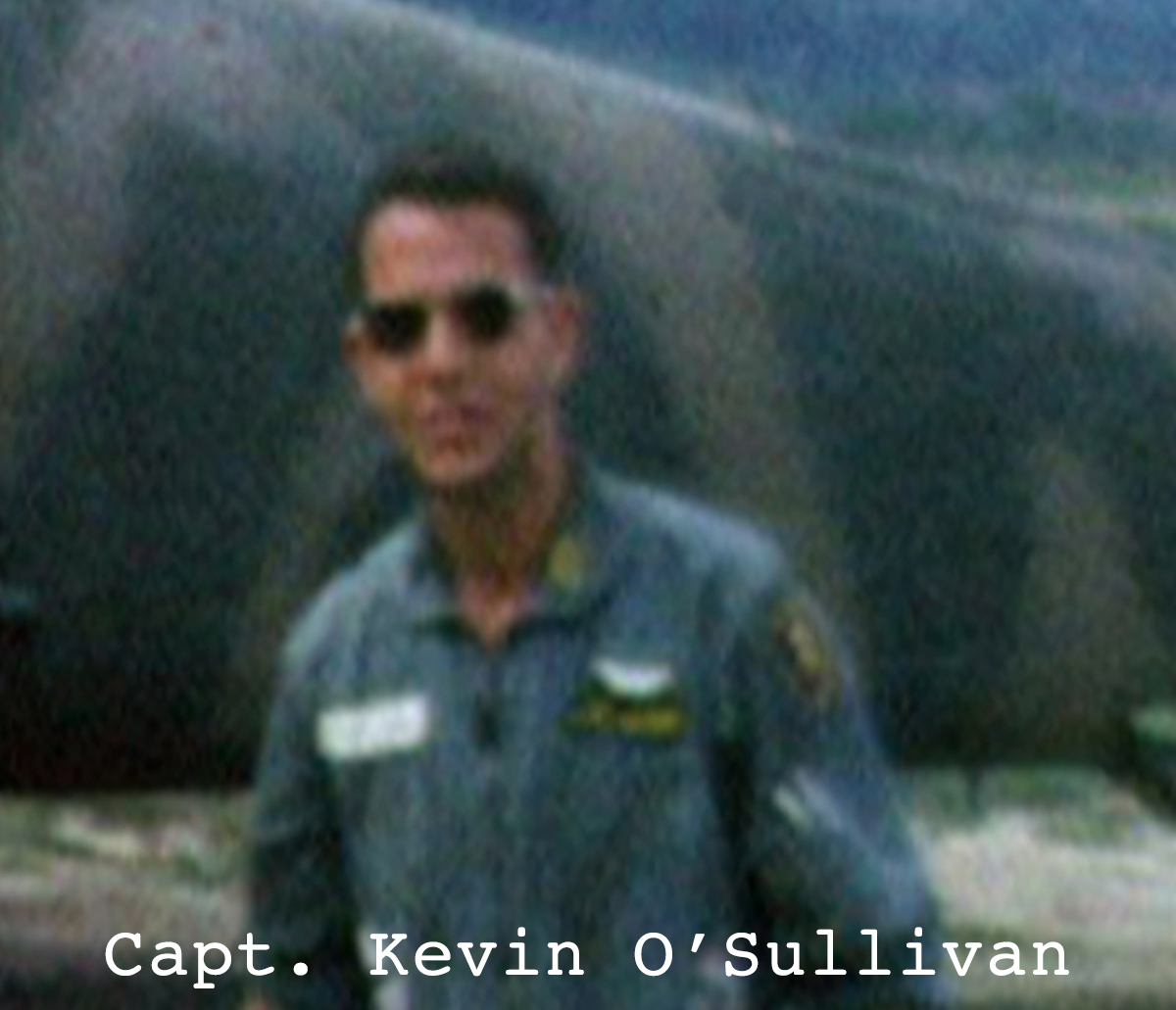
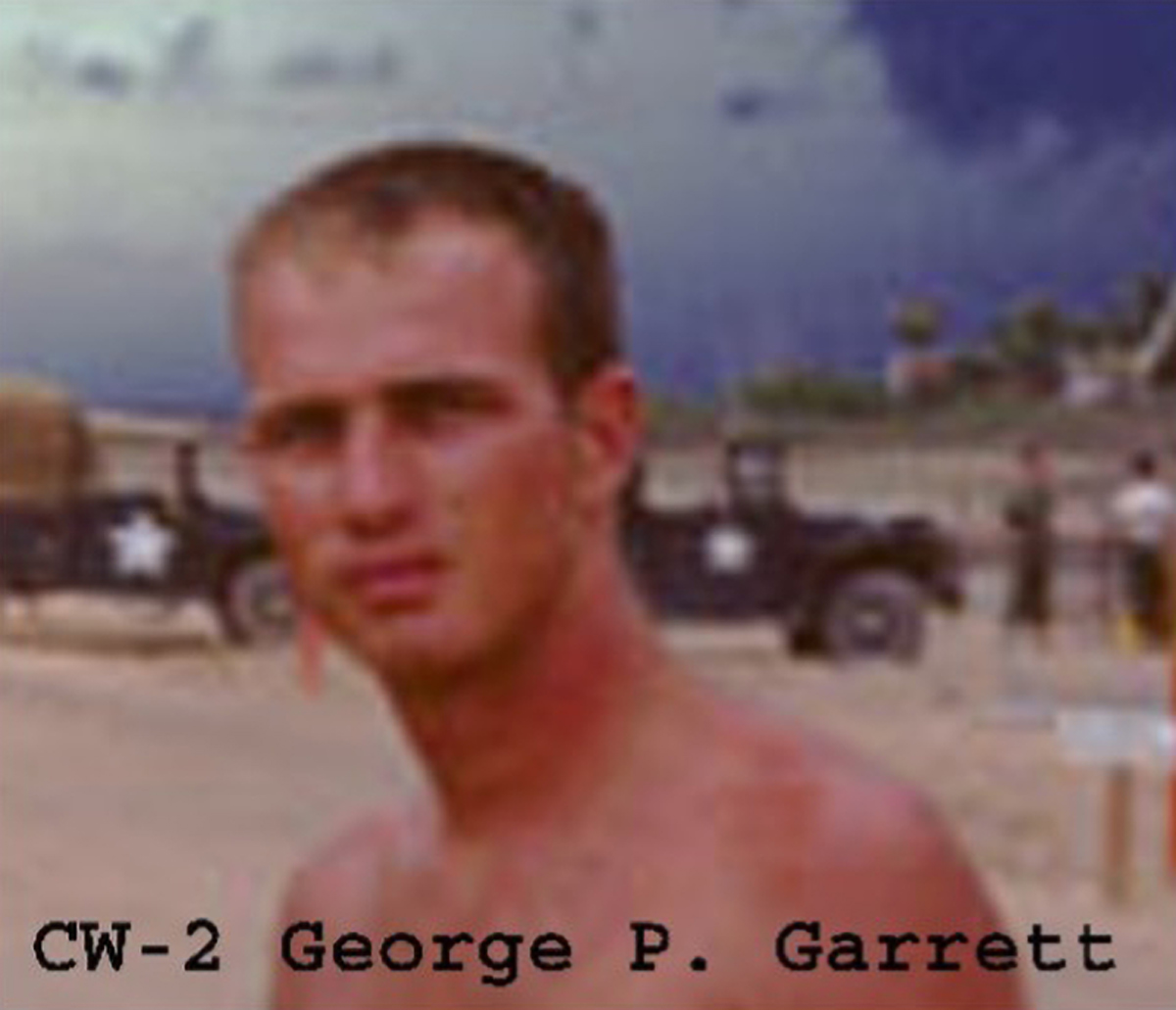
Gunship Team Leader was Crocodile “6”: Capt. Kevin O’Sullivan –Aircraft Commander, CW2 George Garrett – Co-Pilot, Pete Forchini– Crew Chief, and Dwight Strahan – Door Gunner.
The wingman aircraft (SN: 0588) Crocodile “3”: CW2 Gordon Denniston – Aircraft Commander, CW2 Don Gaude – Copilot, Randy Bender – Crew Chief, and Russel Reed – Door Gunner.
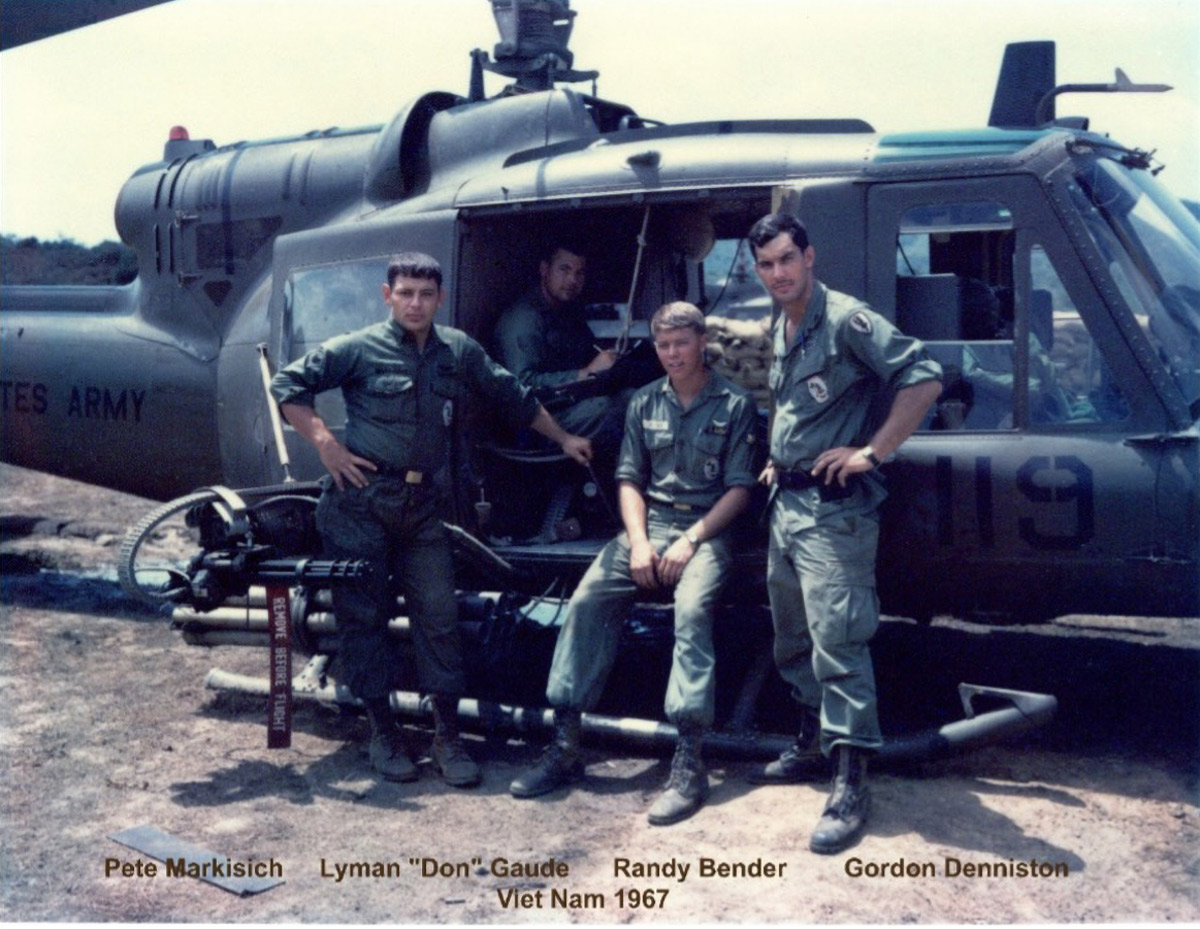
Vietnam, 1967—left to right, Pete Markisich, Lyman "Don" Gaude, Randy Bender, and Gordon Denniston
Pete Markisich was our usual Door Gunner but he was on vacation that day. The Forward Air Controller had a pair of A-1E’s and more F-4 Phantoms circling high above the area waiting to see if we found a large concentration of NVA or their supply depot. The plan was, when we found the enemy, the Tactical Air would drop down and bomb the communists.
Our tactics made the difference between living and dying.
We had gunship rules:
Never fly in the “Dead Man Zone”, Never fly in trail formations (180°)—always be off set from the lead aircraft, do not fly parallel with terrain features like ridge lines, rivers or roads, never overfly the same area on the ground, do not go back to see what you hit or to resee something, and only engage the enemy 90° to the line of fire between the enemy and friendly troops if any friendly troops are in the area. In Laos we were going up against massive numbers of troops with full-automatic AK-47’s and countless NVA big anti-aircraft guns. This could get dangerous.
The NVA had powerful anti-aircraft guns and they knew how to use them. The photo below is a Quad 14.5mm.
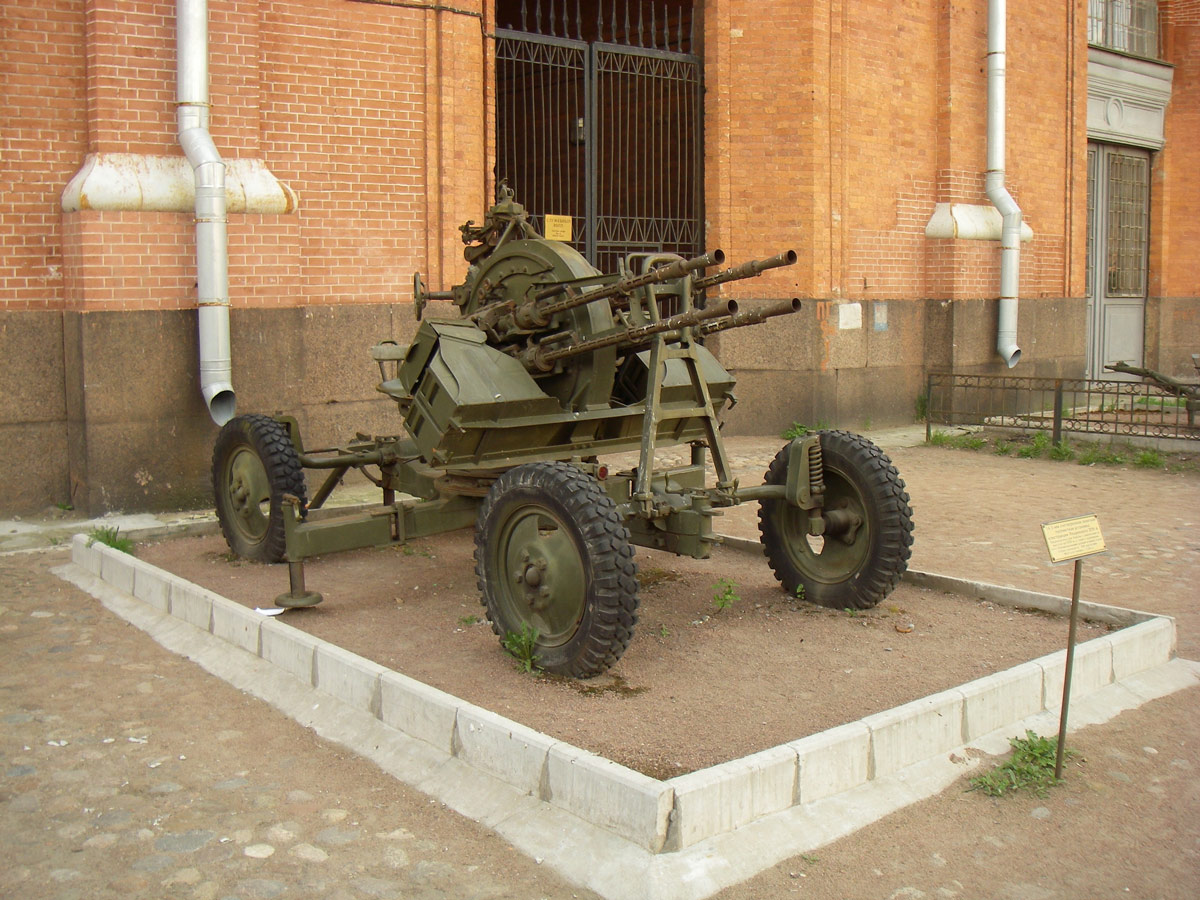
Below is a group of 12.7mm guns.
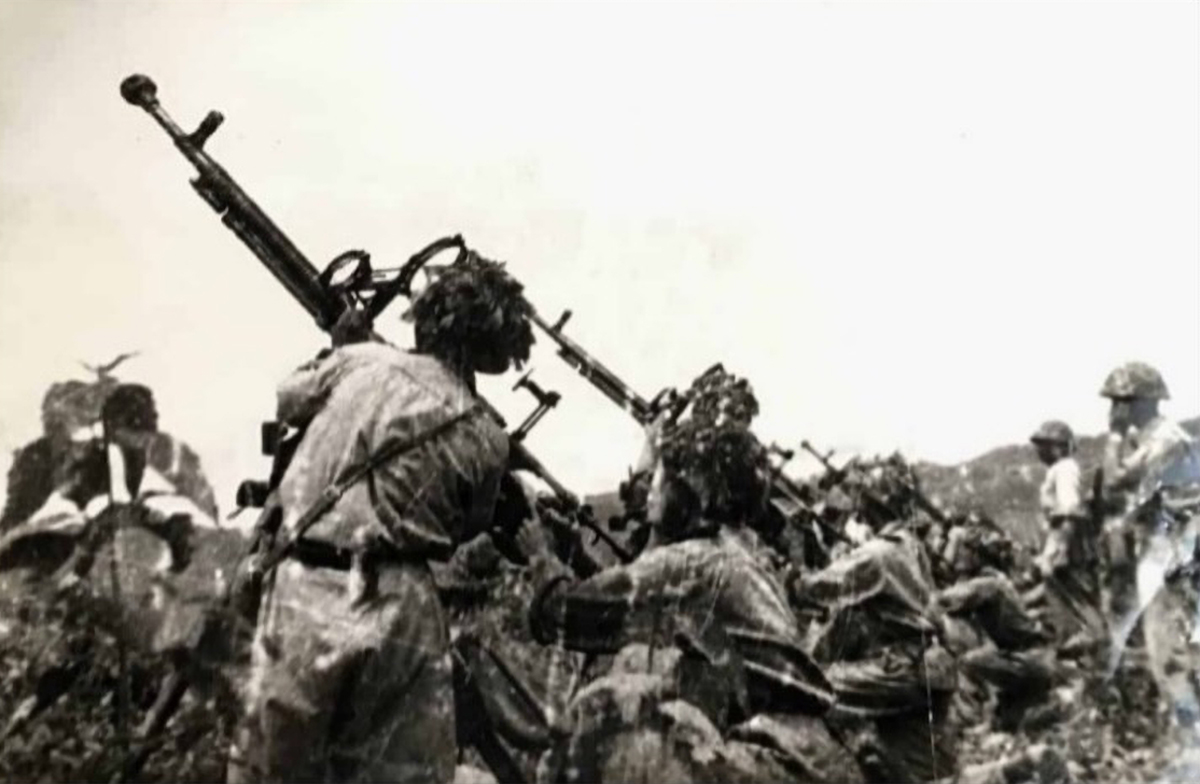
The photo below is a Russian 37mm gun. The 37-mm AA gun—AAA shells had red or green tracers and gave off a sonic “pop” or “whoomph” as they passed near aircraft.
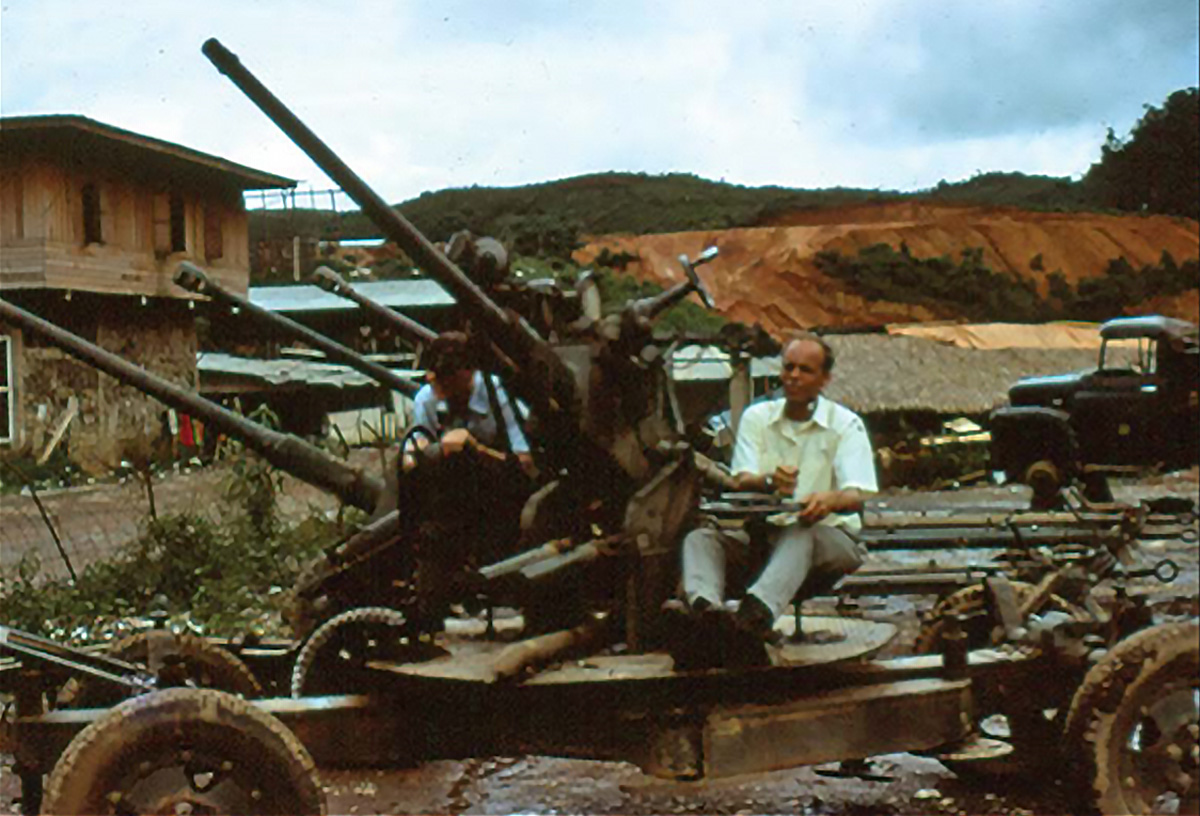
We were going into an area with thousands of enemy troops and we only had two over loaded helicopter gunships and eight men.
You can see in the photos below that taking off with 500 lbs. overloaded above the max gross weight designed for our aircraft was a challenge and our helicopter could not even hover. That required that we make running takeoffs sliding down the runway to gain enough speed to pass through translational lift. It was difficult to stay up in the air until we burned off fuel to reduce weight.
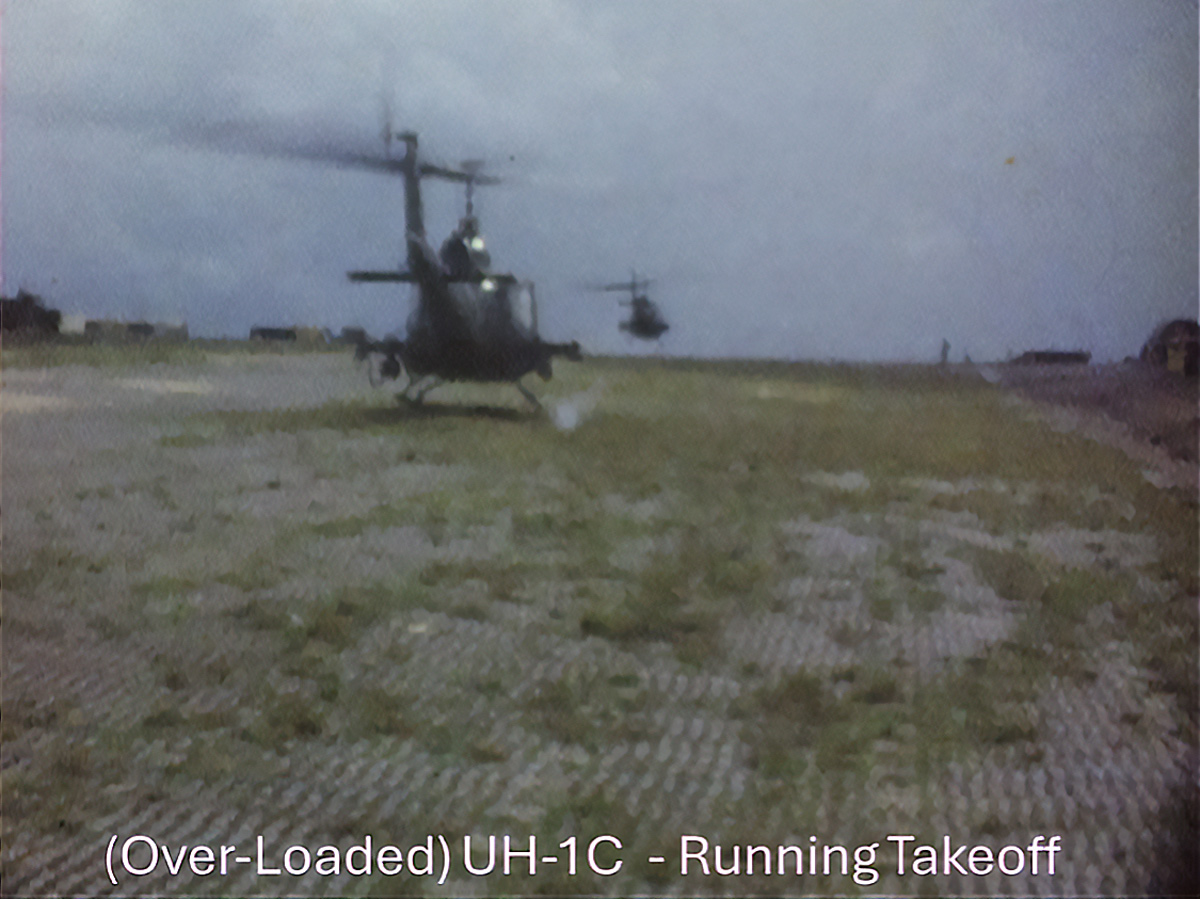
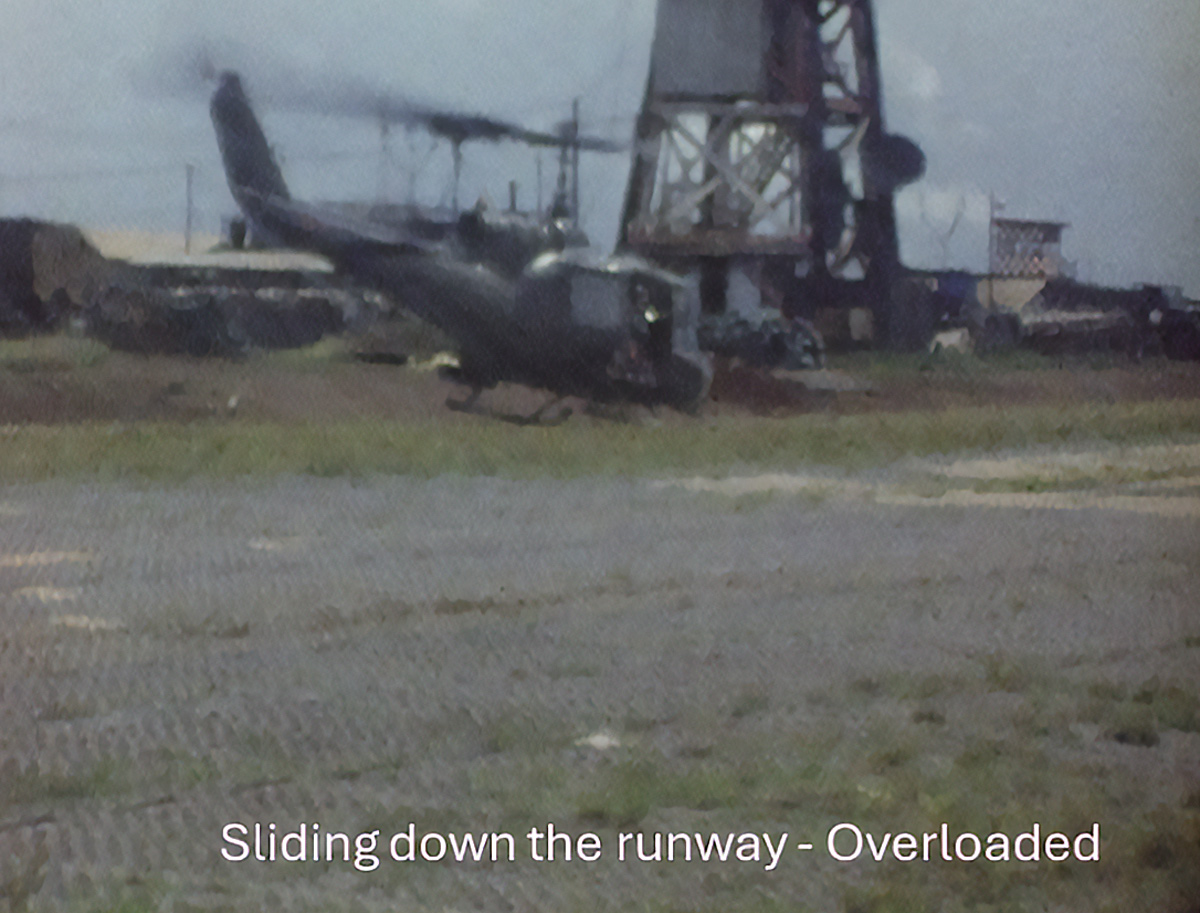
The danger of flying over the Ho Chi Minh Trail cannot be overstated. On one of my missions two gunships in front of me were both shot down in a ball of fire. Laos was a dangerous place for all of us. I was thankful that I was in a helicopter and not going in on the ground. Our tactics were essential to our survival. As air crews we must consider every angle the enemy could use and the terrain could either help us or get us killed. We were going down in a valley flying at a low level that would make it difficult for the enemy to hit us. When you are incredibly low the enemy has less time to know where you are coming from and they only have seconds to prepare, aim, and shoot. When they do shoot, they often miss. If you climb up, they have a good chance to hit you.

If you try to climb up the mountain on the side of the valley you find yourself in the “Dead Man Zone.” They see you; they have time to aim, and they will hit you so climbing out over the mountains on the side of the valley would be deadly if they were in the valley and start shooting.

After flying around looking for the enemy with no luck, Captain O’Sullivan decided on a bright idea. He called me on the radio and said I should shift off to the side behind him because he was going to throw out a hand grenade and “rattle their cage.” I never carried hand grenades on my aircraft because someone may accidentally set them off. What we did not know was there was a division of NVA down there hiding and hoping we did not see them. They saw us and they all got ready to shoot us down if we started shooting at them. The NVA all had orders not to fire on us unless we shot at them. The NVA were all down there waiting for the chance to shoot down a pair of helicopters.
That hand grenade was magic. When it exploded hundreds of NVA opened up on us with their AK-47’s. They were everywhere down there and they all started shooting at our helicopters. I can assure you that when AK-47’s are shooting at you from close range you can definitely hear them and see the muzzle flashes. The NVA came out from concealment so they were standing at remarkably close range (25 feet) pointing at us as they fired. We could now clearly see then since they came out in the open. They had plenty of ammunition and they let it fly. We were receiving automatic fire from every direction.
Sir Winston Churchill: “There is nothing so exhilarating as to be shot at and missed.” Churchill may call it exhilarating but I would call it terrifying. It was like we had gone to a shooting gallery at the state fair and we were dressed up as the targets.
We were flying around at close range and our miniguns were killing NVA in large numbers. Our 2.75in. rockets were killing groups of communists. Our door gunners were knocking down the enemy at close range. Our door gunners had become highly skilled in shooting from the air into enemy on the ground. It was a relief to me when my door gunner took out an NVA soldier who had pointed his AK-47 at me while firing full-automatic from 25 yards. Then we received a radio call from the FAC telling us that we were getting shot at because he could see hundreds of muzzle flashes down in the valley. I doubt that we even answered his call. We were busy flying around in circles and shooting the enemy when we quickly ran out of minigun ammo and Capt. O’Sullivan was completely out of rockets so it was time to leave. Our door gunners had shot up all of their ammo and they were using our M-16’s and pistols as a last resort. It was past time to quickly depart the area so Croc -6 headed to one of the open areas at the mouth of the valley because we did not dare to fly over the mountains that surrounded the valley. The only way out available were the two opening at each end of the valley.
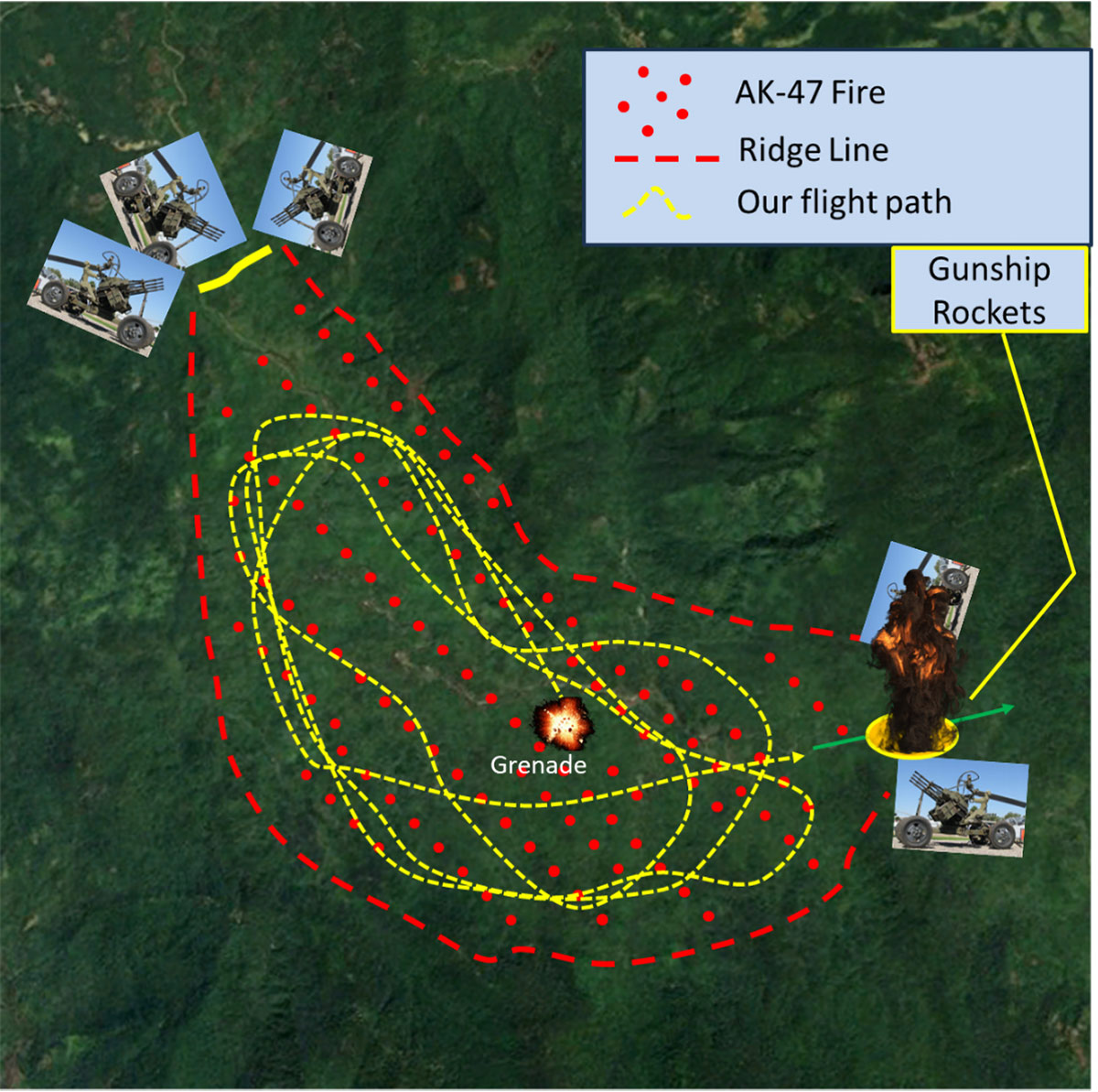
Panic started to set in and things turned serious when Croc-6 approached the opening at the end of the valley because the NVA had a plan. They had set up a bank of anti-aircraft guns and they were shooting straight up in the air creating a fan of solid bullets for us to fly through. We could clearly see the wall of solid tracers straight in front of us. Flying through that wall of fire would have been instant death. Both aircraft made an immediate “U” turn and headed to the other end of the valley only to discover that they had that exit blocked with another wall of fire. As we flew around looking for a way out of the valley the NVA troops in the valley continued firing at us from every direction. There we were flying around the valley getting shot at by hundreds of NVA and we had nothing to shoot back. Now we were just targets.
I always like to save a few rockets so I had two that I had not fired. As we flew around the valley getting shot at, I called “Croc “6” on the radio to let him know that I had two rockets and he could fall in behind me because I planned to head into the wall of fire. I told him to fall in close behind me and I would try to put a hole in the wall of fire. We headed straight toward the end of the valley and the NVA started firing their anti-aircraft guns. Their tracers gave me a clear view of their location and I closed in on their guns. I was closing in fast and so close that I could clearly see the men operating the guns and I watched as they fired straight up into the air waiting for me to fly into their wall of fire. When rockets fire, they are not armed until they reach a certain distance out from my aircraft. The fuse senses the G-forces for a number of seconds then it is armed. I can fire close but if I am too close the rocket will not explode. I needed to be close enough to definitely hit their guns—quick enough so they cannot react to my attack but far enough away so my rockets are armed. When my rockets exploded, they hit perfectly. They destroyed the men and guns in an instance and blew debris, dirt, trees, and the enemy into the air. As I flew through the hole in the wall of fire the dirt and debris had been blown high in the air – so high that it was coming down as I passed through it. “Croc “6” was close behind me so we both made it out without taking any hits.
As soon as we escaped, we headed straight back to Dak To because we were empty and low on fuel. The Forward Air Controller directed the A-1Es and F-4s to roll in on the area to destroy everything in that valley. We had a successful day.
With the massive amount of enemy anti-aircraft fire that day it was a miracle that both aircraft survived. If you crashed the best outcome would be for you to die instantly. If you survived you would have been captured, tortured, and murdered after experiencing a horrible death. The NVA soldiers were not interested in torturing you for information they took joy in your torture and treated it as their entertainment. You rarely hear historians explain this reality.
THE VIETNAM POW VETERAN: IMMEDIATE AND LONG-TERM EFFECTS OF CAPTIVITY by Edna J. Hunter, Ph.D. https://apps.dtic.mil/sti/pdfs/ADA063647.pdf
The number of POWs returned from the war in Southeast Asia (766) was very small indeed when compared with the numbers held captive in Korea (7,140) or during World War II (130,201). The men returned from Southeast Asia (as of 31 December 1976) were a highly select group compared with the POWs of earlier conflicts. The majority were officers, and as a group they were older and more highly educated.
Of those men captured in the North, all but one were air crew members. Five hundred ninety-one Americans, including 25 civilians, were repatriated in early Spring, 1973. An additional 84 men, held prisoner anywhere from 36 hours to five and one-half years, escaped or were released prior to 1973. The military group who returned in 1973 included 325 Air Force, 77 Army, 26 Marine Corps, and 138 Navy POWs. [They murdered all the other POWs].
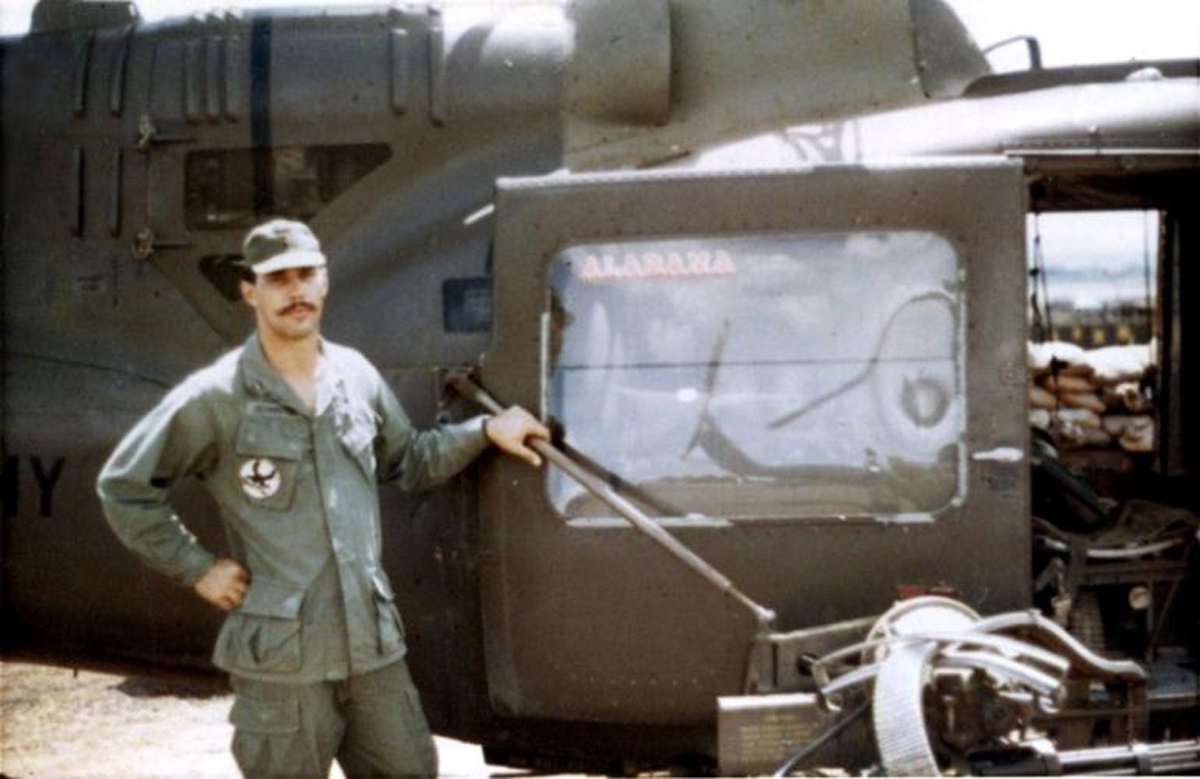
WO Gordon Denniston, “Crocodile 3” 119th AHC, 1967 (Photo courtesy Gordon Denniston, Daphne AL)
ABOUT THE AUTHORS
Gordon Denniston served with the 119th in 1966 and 1967. He returned to Vietnam for a second tour in 1969 and was assigned as General Stillwell’s command pilot. Upon DEROS and ETS, he finished his education at the University of Alabama graduating in 1973.
In 1975 he became an instructor, pilot, and test pilot for Bell Helicopter under contract to the Shah’s Monarchy of Iran. Escaping Iran (under “extreme” circumstances) after the Ayatollah’s revolution, he returned to the U.S. where he became Director of Quality Control for Fairchild Republic, on the build of the A-10 in New York.
From 1984–1993 Gordon was Director of Quality Control for Avco/Textron in Nashville charged with building the wings for the B-1 and C-5. Since 1993, he has run his own company providing project management services in technology and hospital revenue cycle operations for a number of large hospital corporations.
Randy Bender is a 20 year member of the Special Operations Association. He currently lives in Bakersfield, California.
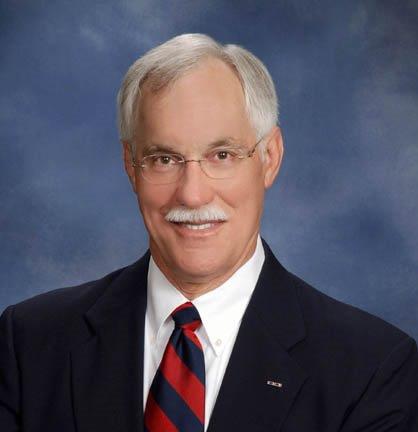
Gordon Denniston
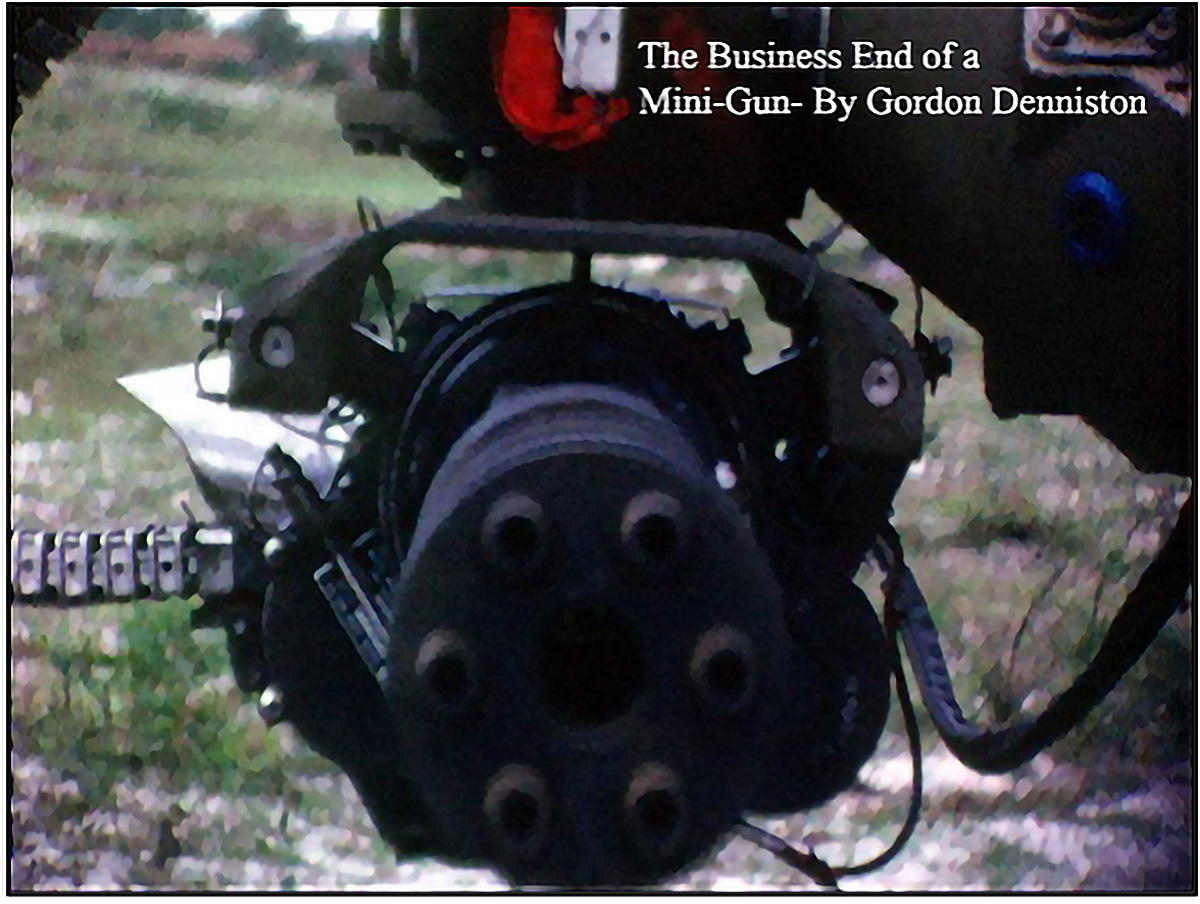
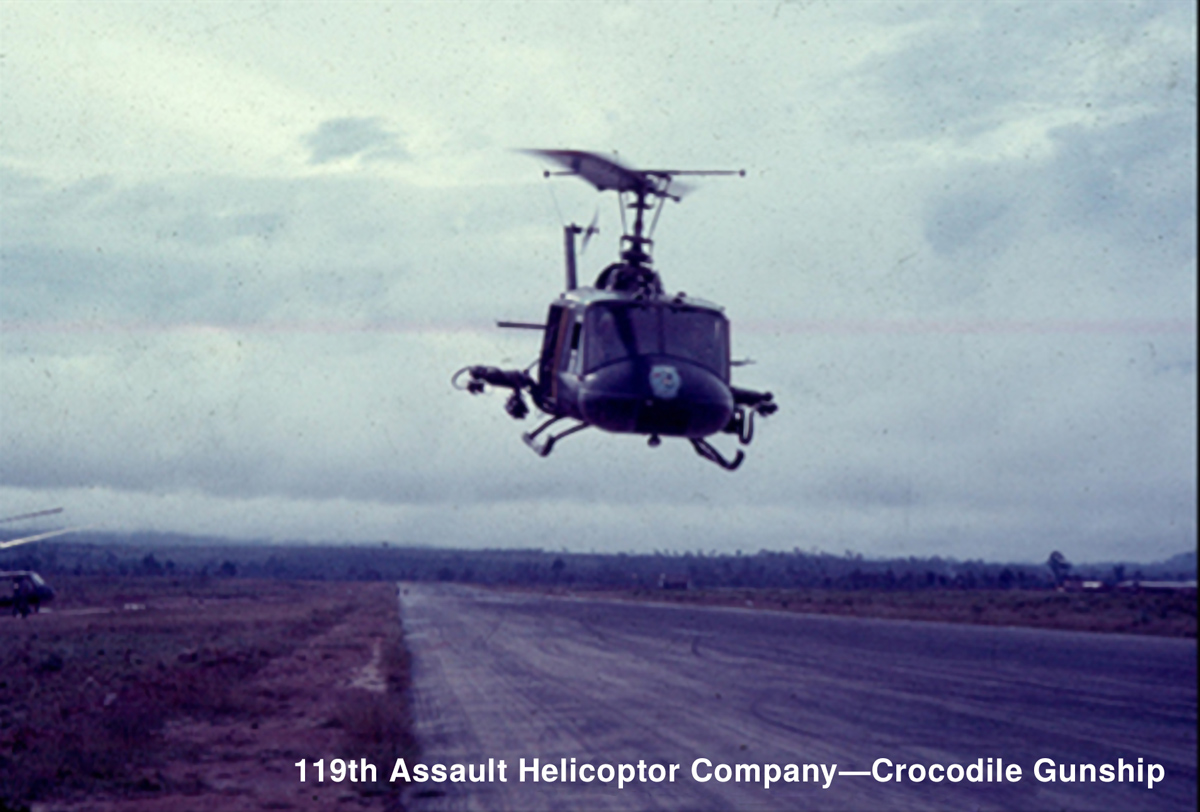
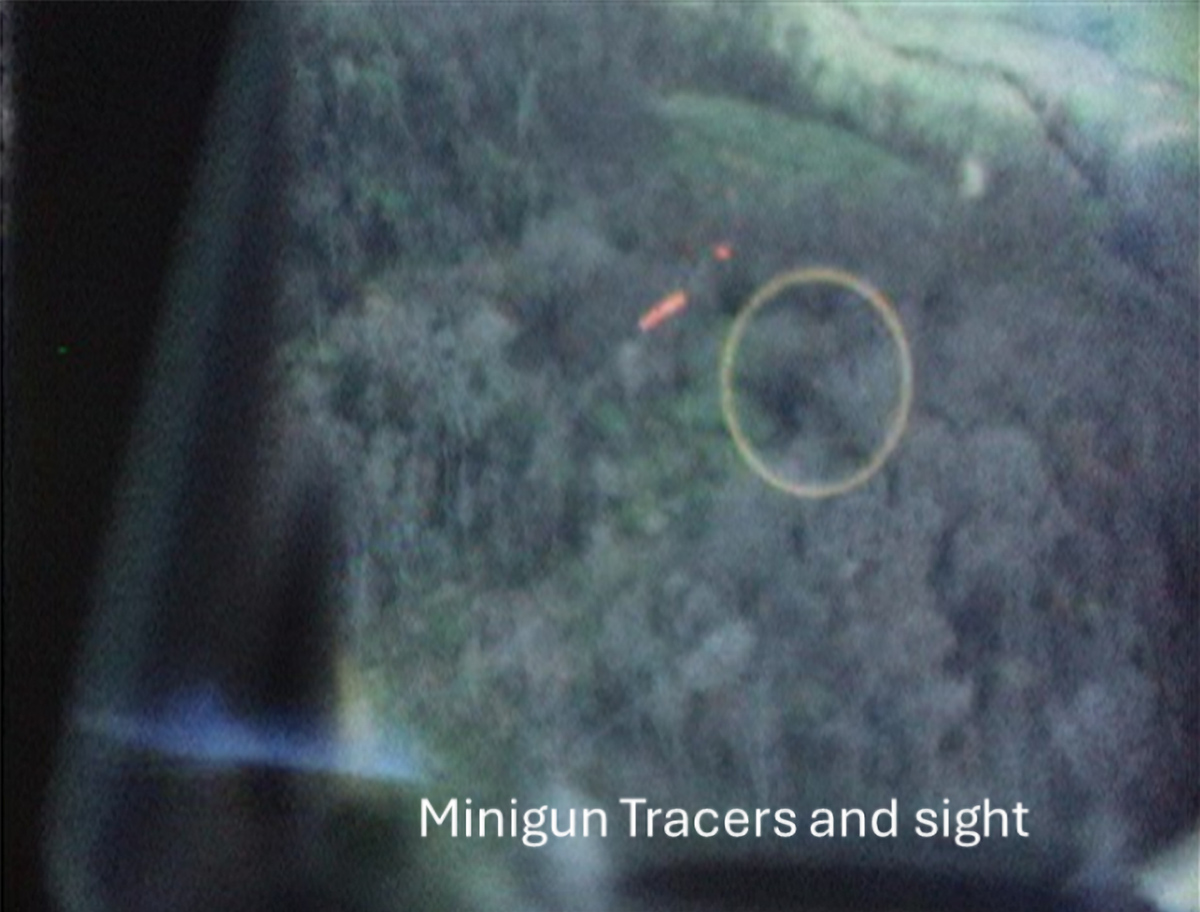
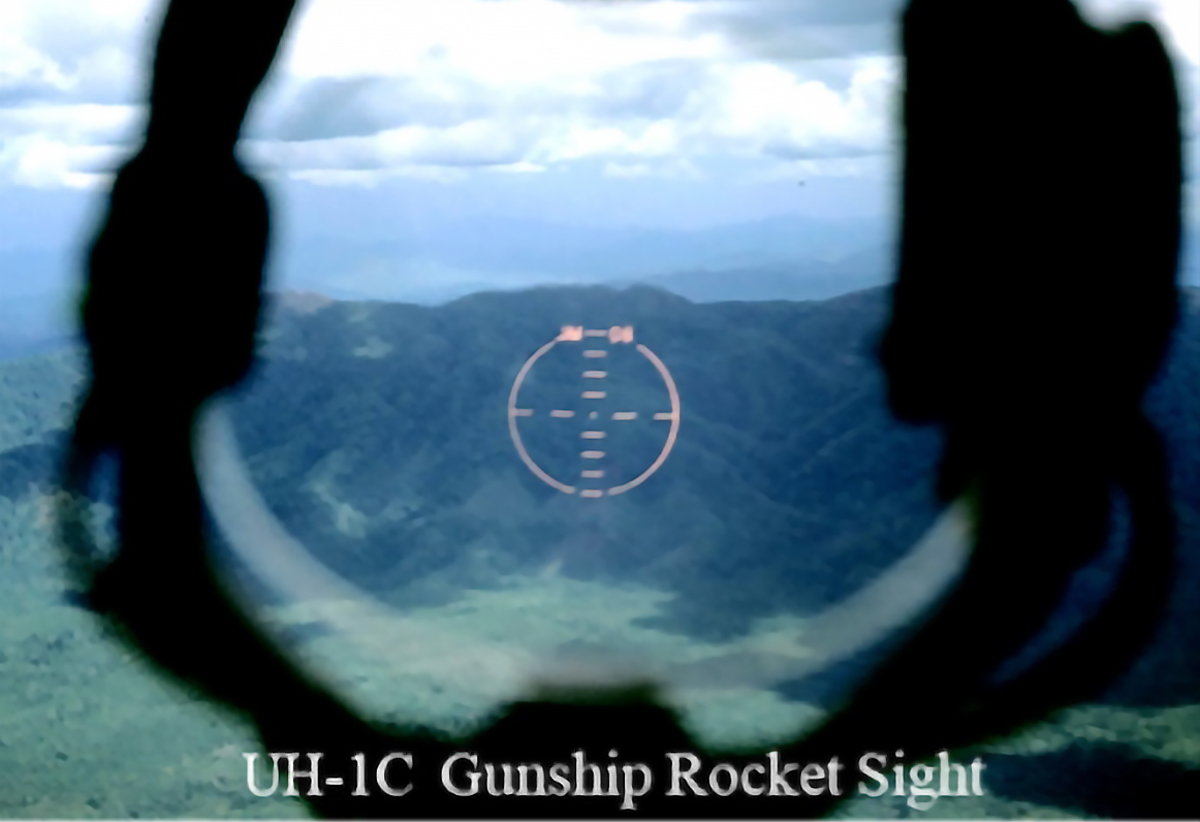
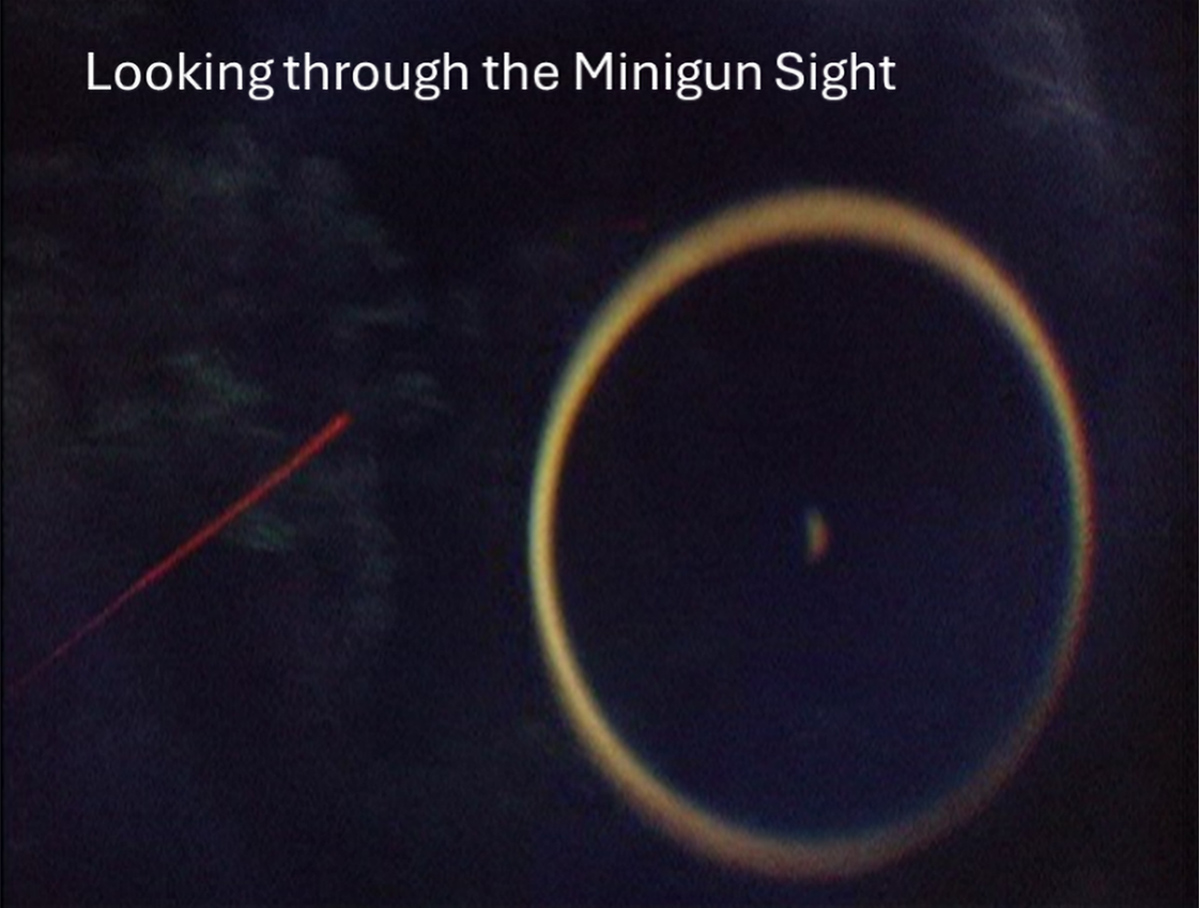
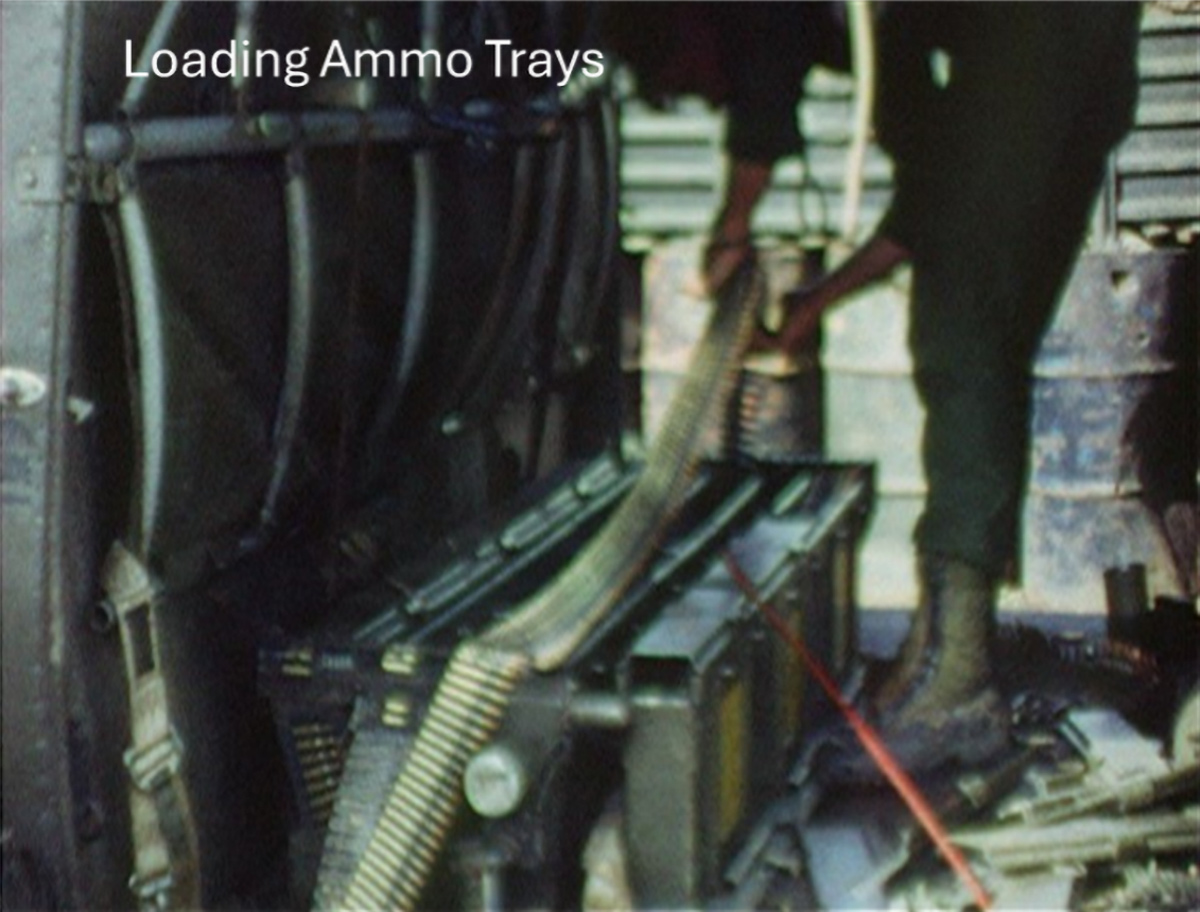
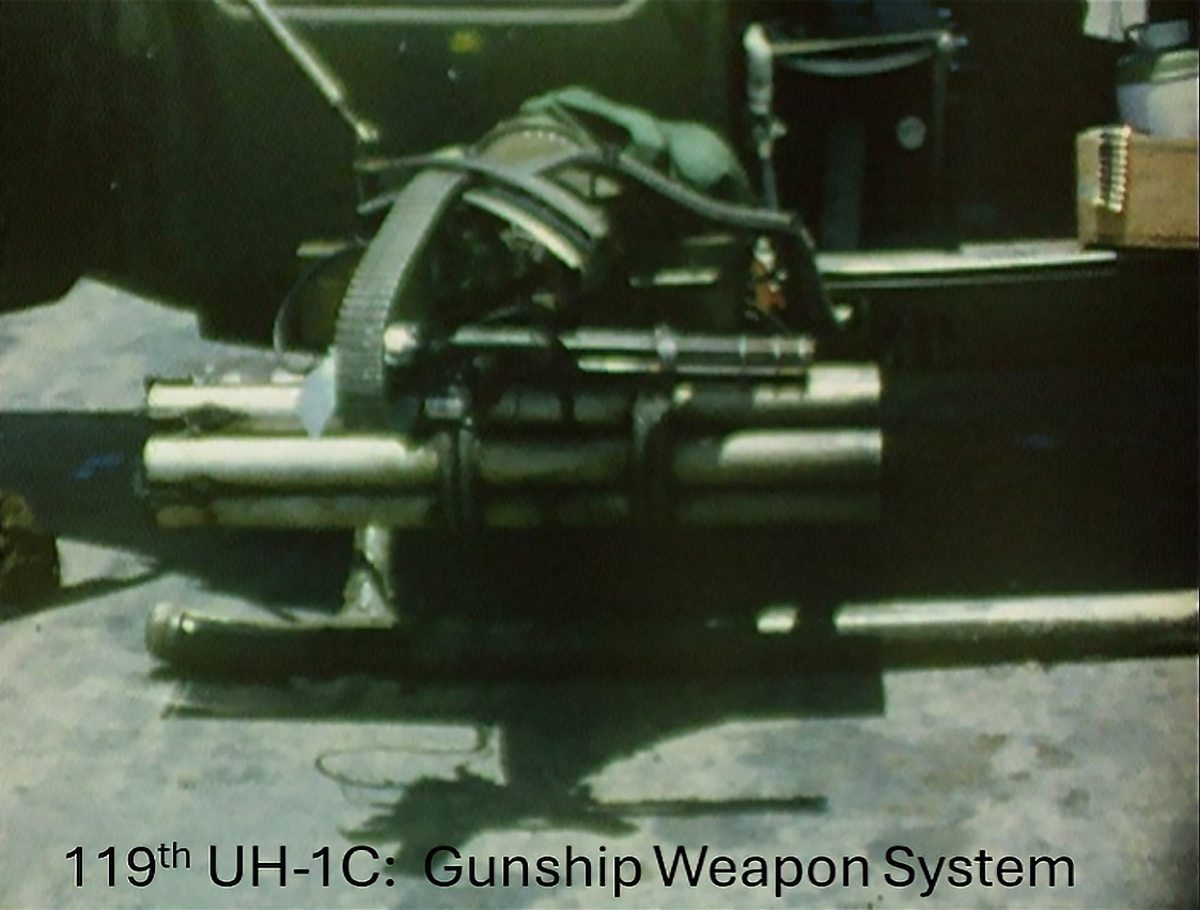
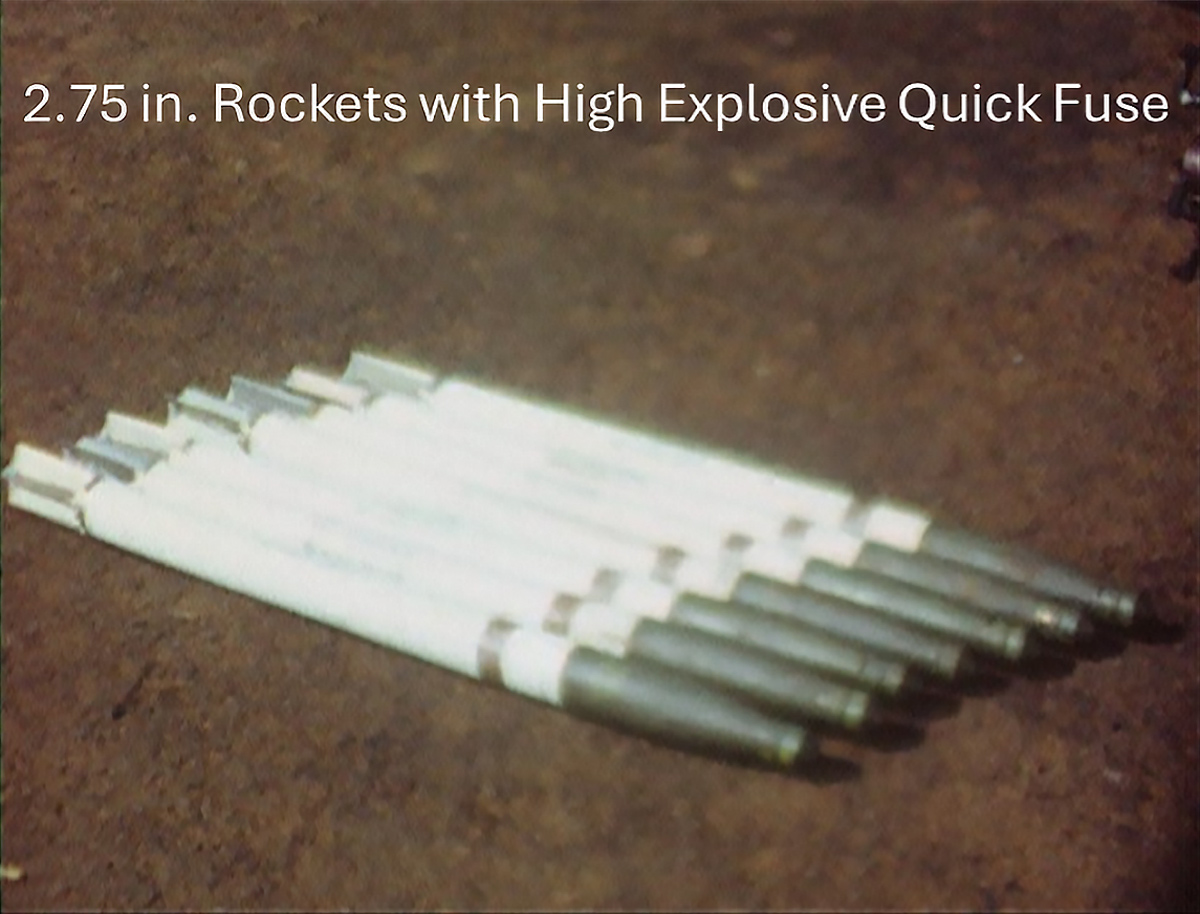
Leave A Comment